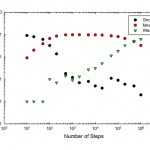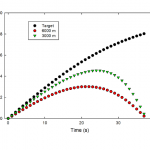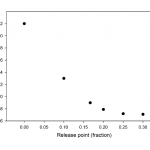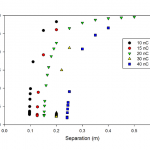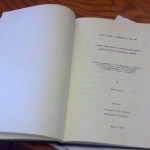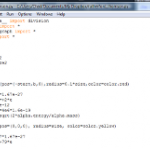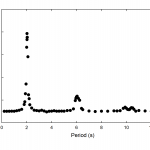Computing
Last week, I did a post for Forbes on the surprisingly complicated physics of a light bulb. Incandescent light bulbs produce a spectrum that's basically blackbody radiation, but if you think about it, that's kind of amazing given that the atoms making up the filament have quantized states, and can absorb and emit only discrete frequencies of light. The transition from the line spectra characteristic of particular atoms to the broad and smooth spectrum of black-body radiation is kind of amazing.
The way you get from the one to the other is through repeated off-resonant scattering. The…
Back in December, The Parable of the Polygons took social media by storm. It's a simple little demonstration of how relatively small biases can lead to dramatic segregation effects, using cute cartoon polygons. You should go read it, if you haven't already. I'll wait.
This post isn't really about that. I mean, it is, but it's using it for something dramatically different than the intended purpose of the post. You see, I am such a gigantic dork that when I looked at their toy model, the first thing that came to mind was physics.
(And, in fact, I sat on this post topic for the better part of a…
Over on Facebook, my colleague Chris Chabris was talking up a smartphone game from a company he's associated with. Which of course got me thinking "Wait, why don't I have a smartphone game company?" (The Renaissance Weekend is also partly to blame, as I was one of about six people there who didn't have a start-up company of some sort...) Which, in turn, led to the realization that there really ought to be a quantum optics video game. Or maybe a series of games, because you could construct a whole bunch of puzzlers around quantum phenomena:
-- The most basic would be to do something like the…
I've decided to do a new round of profiles in the Project for Non-Academic Science (acronym deliberately chosen to coincide with a journal), as a way of getting a little more information out there to students studying in STEM fields who will likely end up with jobs off the "standard" academic science track.
The eleventh profile of this round features Benoit Hamelin, a biomedical engineer turned network defense programmer.
1) What is your non-academic job? I am Chief Scientist for Arc4dia, a small company in the computer security and private network defense business. I develop software, lead…
I've decided to do a new round of profiles in the Project for Non-Academic Science (acronym deliberately chosen to coincide with a journal), as a way of getting a little more information out there to students studying in STEM fields who will likely end up with jobs off the "standard" academic science track.
Fourth in this round is a Union alumn (another nice bonus of this is getting to promote some of my college's former students...) who prefers to remain anonymous, but is a computer engineer turned web developer for a public relations firm.
1) What is your non-academic job? I'm a web…
I've decided to do a new round of profiles in the Project for Non-Academic Science (acronym deliberately chosen to coincide with a journal), as a way of getting a little more information out there to students studying in STEM fields who will likely end up with jobs off the "standard" academic science track.
Third in this round is a physics teacher turned developer of physics education technology at Vernier.
1) What is your non-academic job? Title: Physics Education Technology Specialist
Dept: Tech Support and R&D
Responsibilities:
Support teachers using Vernier sensors, interfaces, and…
I've decided to do a new round of profiles in the Project for Non-Academic Science (acronym deliberately chosen to coincide with a journal), as a way of getting a little more information out there to students studying in STEM fields who will likely end up with jobs off the "standard" academic science track.
Second in this round is a computer scientist turned underwater warrior. With bonus video!
1) What is your non-academic job? I am a computer scientist at the Naval Undersea Warfare Center in Newport, RI. I work in the Ranges Department as a part of the Range Software branch. That means I…
I've decided to do a new round of profiles in the Project for Non-Academic Science (acronym deliberately chosen to coincide with a journal), as a way of getting a little more information out there to students studying in STEM fields who will likely end up with jobs off the "standard" academic science track.
First up in this round is a CS major turned IP lawyer.
1) What is your non-academic job? I am an intellectual property attorney. I work for a "boutique" law firm, which means it specializes in one area of law (that being intellectual property, naturally). I work on all areas of IP,…
Julia is a nifty new language being developed at MIT
I stole this plot from github, it shows Julia's current performance on some standard benchmarks compared to a number of favourite tools like Python, Java and R. Normalized to optimized C code.
And, there, in a single plot, is why Real Programmers still use Fortran...!
So, last week I idly wondered about the canonical falling-bomb whistle. The was originally intended to be a very short post just asking the question, but I got caught up in thinking about it, and it ended up being more substantial. And leaving room for further investigation in the form of, you guessed it, VPython simulations.
This one isn't terribly visual, so you don't get screen shots, just a link to the code at Gist. It's a simulation of a falling bomb, with air resistance, tracking the velocity as a function of time. Then it calculates a "Doppler shift" using the velocity as a fraction of…
In comments to the post on computer display colors, Will Slaton notes that Mac displays emit polarized light. And, indeed, this is an inherent part of the backlit LCD technology-- the individual pixels are bits of liquid crystal between two polarizers, and an applied voltage causes the liquid crystal molecules to flip between a state where they rotate the polarization of light, and a state where they don't. In one of those configurations, the polarizers block the light, and in the other, they let it pass. By rapidly varying the voltages, you can make the pixels flash on and off in the right…
This year's "Flame Challenge" is to explain color in terms an 11-year-old can follow. I have opinions on this subject, a background in AMO physics, and access to scientific equipment, so I'm putting something together. In the course of this, though, it occurred to me to wonder how my different portable computing devices process color. And since I have access to an Ocean Optics USB4000 spectrometer, I can answer this question in more detail than anybody needs.
So, I have three principal electronic devices that I use to do computer-type things: a Moto X smartphone, an iPad, and a Lenovo…
Last week, Rhett did a post on animating a bouncing ball in VPython. This was mostly making a point about the distinction between real simulation and animation, along the lines of yesterday's post on social construction of videogame reality. But, of course, my immediate reaction was, "That's not how a bouncing ball looks..." This is how a bouncing ball looks:
(As you can see from the watermark, I'm trying out a new video editor...)
This is footage of four different types of balls bouncing on a lab cart in our stockroom, shot in gratuitous slow motion (240 fps) because I'm still playing…
Both SteelyKid's kindergarten and the snow-day day-care program that the kids go to were closed today, which kind of threw a wrench in things. But it's also kind of fun, as I got to spend some time playing outside with SteelyKid on her play set in the snow. The "featured image" above is a cell-phone snap from this, and I got three short video clips of her going down the slide.
Of course, it's kind of stupid for these to be three separate YouTube clips, but when I went to stick them together using Windows Movie Maker (which is what I've used for this sort of thing in the past), it turns out…
I realize people are getting sick of reading me talk about this charged-tape business, which has run to one, two, three, four posts at this point. Truth be told, I'm losing enthusiasm for it myself. So this will be the final post, at least for now...
As I mentioned on Twitter, as I type this stuff up for the blog, I've toyed with the idea of hanging onto it instead, and writing it up for The American Journal of Physics or The Physics Teacher, so I could get a little professional credit for it. There are two problems with that (other than that some stick-in-the-mud editor or reviewer might…
In the previous post about simulating the attraction between sticky tapes using VPython, I ended with a teaser mentioning that there was a discrepancy between the simulation and the theoretical solution from directly solving the equations. The problem is kind of subtle, but clearly visible in this graph from that post:
Data for the toy model version of the system, showing the equilibrium position as a function of initial separation.
In this, we see the equilibrium position that the mass-on-a-spring settles into as a function of the initial separation between the charges in the toy model.…
Having spent a lot of time solving equations related to sticky tape models, including trying to work solutions in my head while driving to Grandma and Grandpa's with the kids, and making some measurements of real tapes, there was only one thing left to do: try simulating this problem in VPython. Because I'm a physics nerd who knows just enough about programming to be dangerous...
Finding the full solution to the real sticky tape scenario is kind of a miserable process, because it involves a long continuous tape with charge all down its length, which is kind of complicated, and then there's a…
We cleared a bunch of space in our deep storage area over the summer, and one of the things we found was a box full of old student theses from the 1950's and 1960's. The library already had copies of them, but I thought it was sort of cool to have a look into the past of the department, so we put them up on a shelf in the office. Yesterday, I was glancing over this, and spotted a thin volume, pictured in the "featured image" above, which was a Master's thesis from 1960 (when we used to give MS degrees in physics...) titled "A Monte Carlo Study of Neutron Scintillation Detection with a…
Two chapters of the book-in-progress will be devoted to the development of the modern understanding of the atom. One of these is about the Bohr model, which turned 100 this year, but Bohr's model would not have been possible without an earlier experiment. The actual experiment was done by Ernest Marsden and Hans Geiger, but as is the way of such things, the historical credit mostly accrues to their boss and noted force of nature, Ernest Rutherford. This is the experiment that established the cartoon image of an atom as a solar system, which is utterly unworkable using classical physics, and…
Some time back, I spent a bunch of time writing a VPython program that simulated the motion of a pendulum, which turned out to do some strange things. In the comments to that, there were two things worth mentioning: first and foremost, Arnoques at #5 spotted a small error in the code that fixes the odd behavior noted in that post-- when I corrected it, the stretch needed to keep the pendulum swinging smoothly without oscillating in and out along the string was exactly what you would expect (the "factor" plotted in that earlier post is infinitesimally smaller than 1.0-- I got bored trying to…
